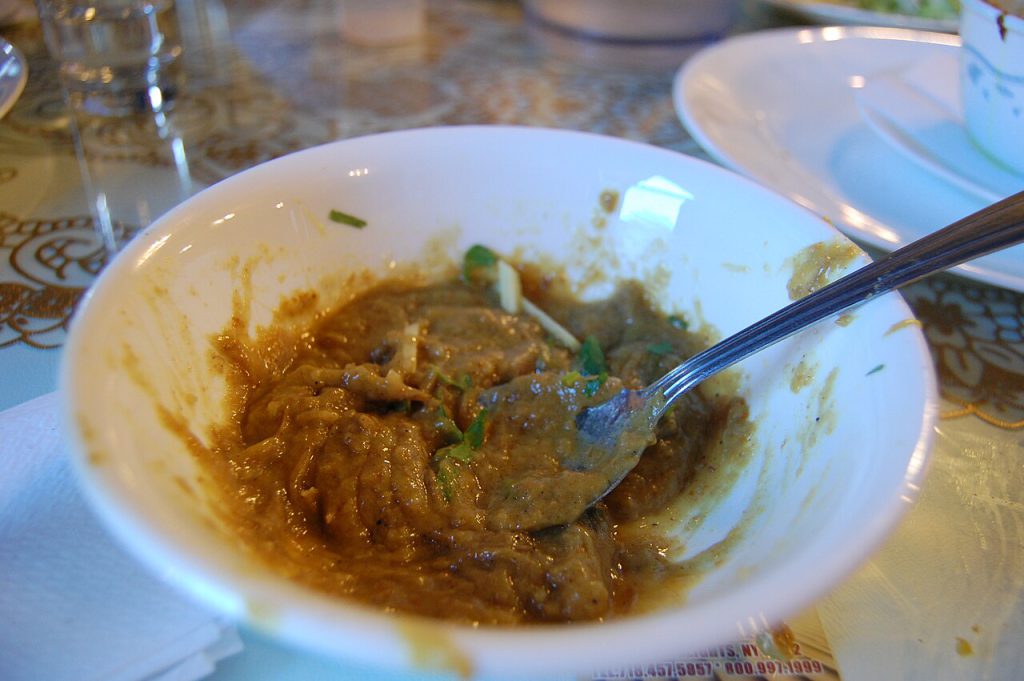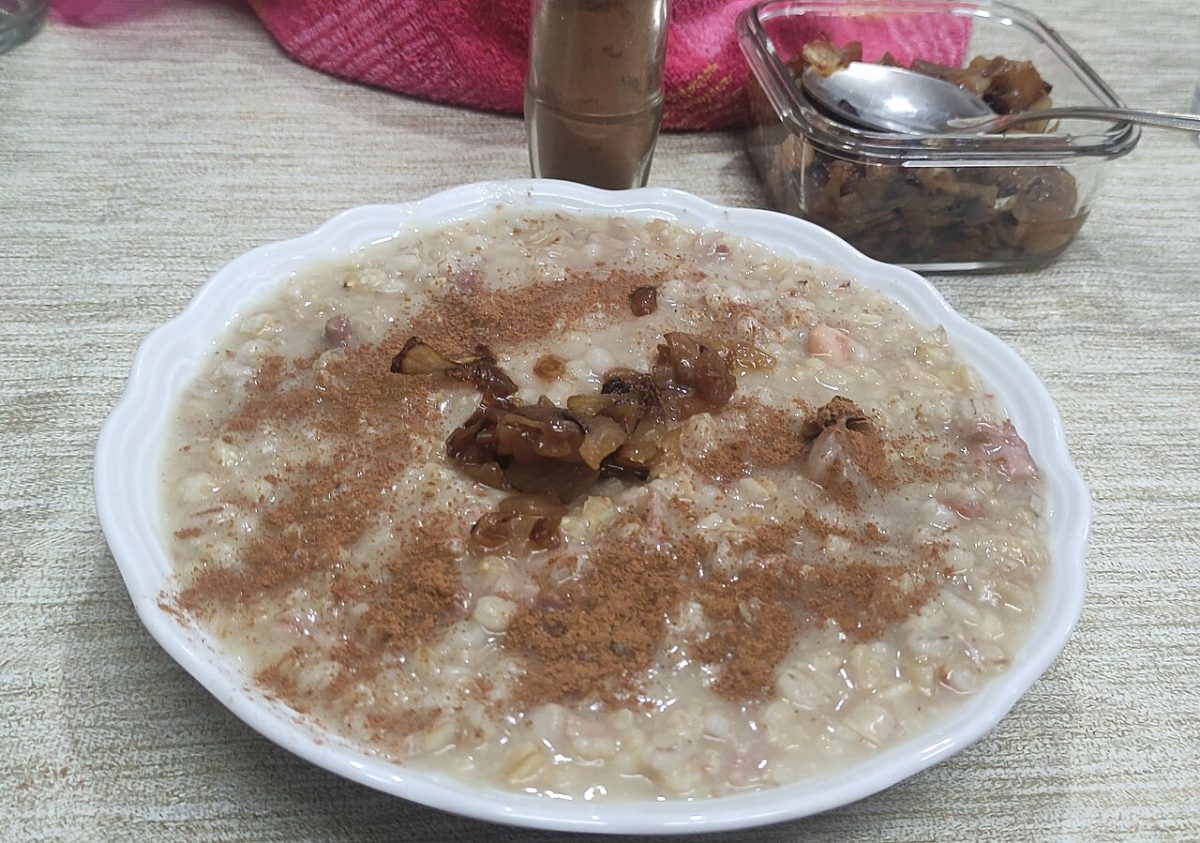Table of Contents
Persian Haleem, a beloved morning meal in Iran, is a hearty dish made from wheat and your choice of beef, lamb, or turkey. It takes time to cook, but it’s worth the wait! In Iran, you can find it in restaurants early in the morning or grab it to go. Some cooks stick to the old way, cooking the wheat slowly and stirring it all night. But thanks to modern kitchen tools like food processors and mixers, making haleem is much quicker now.
Whether you’re grabbing a quick bite from a restaurant or making it at home, you can still enjoy Iranian Haleem with modern convenience.
Persian Haleem History

The tale of Persian haleem’s beginnings is like a colorful rug woven from different threads, all leading back to the lands we now call Iran and Afghanistan. One story says haleem’s story starts in ancient Persian folklore and religious texts, like the Shahnameh and Avesta, where it’s described as a special dish.
Another story takes us to the courts of King Khosrow I, ruling in the sixth century in Persia. It’s said that Iranian haleem was first served there, a mix of grains, meat, and spices fit for kings and common folks alike. Whether it’s born from ancient tales or royal kitchens, haleem’s journey from Iran and Afghanistan has left its mark on food all over the world.
Persian Haleem Ingredients
- 3 cups of wheat, washed and soaked for 6-8 hours or overnight in 6 cups of water. Then, drain.
- 2 pounds of lamb neck or turkey breasts
- 1 medium onion (cut into quarters)
- 1 cup of milk
- Salt (as needed)
- Oil (as needed)
Persian Haleem Recipe
Here’s the Iranian Haleem recipe:
- 1. To begin making tasty haleem, start by soaking the wheat. Here’s how: Pour the wheat into a bowl the night before, fill it with water, and let it soak thoroughly.
- 2. After soaking, drain the wheat and transfer it to the cooking pot for the haleem. Pour about 6 to 7 glasses of water over the wheat. Place the pot on low heat and let the wheat cook slowly (To make sure your haleem tastes good, it’s important to stir the wheat every few minutes while it’s cooking. This prevents it from sticking and ensures even cooking).
- 3. After that, wash the meat thoroughly and place it in a pot over low heat to cook (While the meat is cooking, remember to keep stirring the haleem mixture well).
- 4. Now, transfer the meat to a suitable pot and add enough water to cover the surface of the meat. Peel the onion, cut it into four pieces, and add it to the pot along with some turmeric (Adding onion is essential for enhancing the aroma of the meat).
- 5. Next, chop the cooked meat. Wait until the wheat is well pureed. Then, pour the chopped meat into the pot with the wheat mixture. Add some salt to taste.
- 6. In this step, stir the mixture thoroughly. Pour a tablespoon of oil into the pot and continue stirring the ingredients to prevent the wheat from sticking to the bottom of the pot.
- 7. Reduce the heat to low completely to ensure the cooking process proceeds smoothly. Keep stirring the ingredients until excess water is absorbed into the pot (Remember, haleem tends to harden after cooling, so don’t let all the water evaporate completely).
- 8. To make haleem, you need to stir it continuously until it reaches the desired consistency. Patience is key here, and cooking it gently over low heat will yield a better taste. Your haleem is ready!
Serving Persian Haleem
First, scoop some warm Haleem into a bowl. Now, let’s add toppings! Sprinkle on sesame seeds for crunchiness and scatter-sliced almonds for extra flavor. Add some dried damask rose petals for a fancy touch. Finish off with a sprinkle of sugar and a dash of cinnamon.
These ingredients are common in Persian Haleem and make it taste sweet and cozy. Your tasty bowl of Persian Haleem is now ready to enjoy!
Persian Haleem and Iranian Culture
Nazri
In ancient times, Iranians began a lovely tradition called Nazri. During their religious events, they cooked up food to share with others. This special food, called Nazri, isn’t just any food—it’s a gift given freely to everyone, whether they’re rich or poor, friends or family. And guess what? Persian Haleem is often among the favorites for Nazri (especially during the Muharram month). It’s a beautiful way to spread kindness and bring people together, celebrating the spirit of generosity that’s been cherished for generations.
Ramadan
Ramadan is a big deal in Iran. People fast from sunrise to sunset, and when it’s time to break the fast, families gather for a meal called Iftar. Haleem is super popular during Ramadan. It’s the go-to dish for family get-togethers. Why? Because it’s yummy, filling, and gives you a boost after a day of fasting. Plus, you can make a lot of it to feed a big crowd. So whether it’s a small dinner or a big celebration, Haleem brings everyone together to enjoy the spirit of Ramadan.
Where to Eat Persian Haleem in Tehran
Majid Haleem
Majid Haleem, located in Tehran is a cozy spot that serves up delicious Persian dishes. When you step inside, you’re greeted by the amazing smell of spices and slow-cooked meats. This place isn’t just about food; it’s about carrying on a family tradition. Every ingredient is chosen carefully to make sure each bite is bursting with flavor. From the juicy lamb to the fragrant saffron, every spoonful tells a story of love for Persian cooking.
Seyed Mehdi Haleem
Seyed Mehdi Haleem is a restaurant in Tehran that mixes old recipes with new ideas. It’s in the middle of the city’s food scene and stands out for keeping the traditional flavors alive while adding a modern touch. The haleem here is a perfect example of this mix, blending classic tastes with exciting new twists. Each mouthful is a surprise, with different textures and flavors that stay with you even after you’re done eating. Seyed Mehdi Haleem isn’t just a place to eat; it’s a celebration of how food evolves over time while still staying true to its roots.
Moslem Restaurant
Moslem Restaurant in Tehran is famous for its tasty Persian haleem. Located in a busy part of the city, this place is loved by locals and tourists alike.
As soon as you walk in, you’re greeted by the smell of cooking spices and grains. They make their haleem the traditional way, with care and attention to detail, ensuring every spoonful is full of flavor.
FAQs about Persian Haleem
Q1: What is Persian Haleem made of?
A1: Haleem has four main parts: Grain, like wheat or barley, which are usually included. Pulses (like lentils) and rice might be added, depending on where the recipe comes from. Meat is also a key ingredient, often beef, lamb, mutton, goat meat, or chicken.
Q2: What does Haleem mean in Persian?
A2: Haleem is a tasty and nutritious dish enjoyed in Iran and some Middle Eastern nations. It’s made from ground wheat and meat.
Q3: Is Persian Haleem healthy?
A3: Haleem can be a healthy choice for your meals, as long as you skip the oily layer that’s common in many South Asian dishes!
Q4: How to eat Persian Haleem?
A4: Separate the haleem into eight bowls. Add 1 tablespoon of the remaining melted ghee and a sprinkle of ground cinnamon on top of each bowl. If you’d like, you can also sprinkle some sugar and sesame seeds on top according to your taste. Then, dig in and enjoy!
Q5: What is Haleem called in English?
A5: Haleem is a thick stew made from meat, lentils, and crushed wheat.
Last Words: Experience the Best of Persian Haleem with a Customized Tour
In Iran, people love eating Persian Haleem for breakfast. It’s a tasty meal made from wheat and either beef, lamb, or turkey. It takes a while to cook, but it’s delicious! You can have it at restaurants in the morning or get it to take away. Some cooks still make it the traditional way by cooking the wheat slowly and stirring it all night. But nowadays, with kitchen gadgets like food processors and mixers, making haleem is faster.
If you’re a food lover excited to taste new flavors, Iran is the place to be. But to truly enjoy this dish and other Iranian foods, you need more than a standard tour. At To Iran Tour, we specialize in making Iran tours and travel packages that suit your interests. Our team will create an itinerary focused on food, including chances to taste Persian Haleem. With To Iran Tour, you’ll have an amazing culinary journey in Iran. Whether you’re traveling alone, with family, or in a group, we’ll take care of the details so you can focus on enjoying the food and culture of Iran.
Get ready for a food adventure in Iran with To Iran Tour and experience the deliciousness of Persian Haleem while enjoying the beauty and hospitality of Iran.

